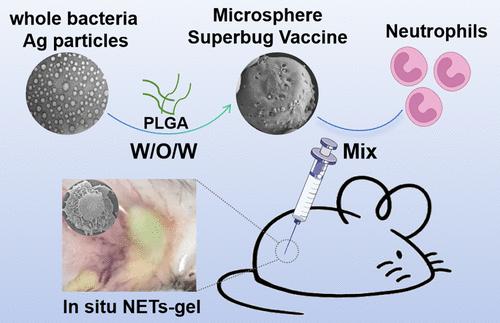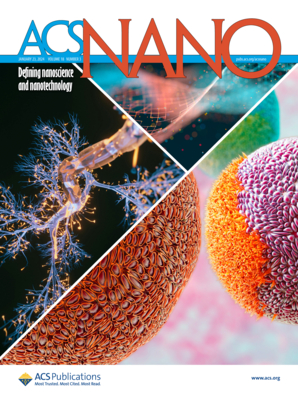Vaccine Specifically for Immunocompromised Individuals against Superbugs
IF 15.8
1区 材料科学
Q1 CHEMISTRY, MULTIDISCIPLINARY
引用次数: 0
Abstract
Immunocompromised populations, including cancer patients, elderly individuals, and those with chronic diseases, are the primary targets of superbugs. Traditional vaccines are less effective due to insufficient or impaired immune cells. Inspired by the “vanguard” effect of neutrophils (NE) during natural infection, this project leverages the ability of NE to initiate the NETosis program to recruit monocytes and DC cells, designing vaccines that can rapidly recruit immune cells and enhance the immune response. The PLGA microsphere vaccine platform (MSV) with a high level of safety contains whole-bacterial antigens both internally and externally, providing initial and booster effects through programmed distribution and release of antigens after a single injection. Experimental data indicate that immunizing mice with a mixture of MSV and NE induces the formation of spontaneous gel-like neutrophil extracellular traps (NETs) at the inoculation site. These NETs recruit immune cells and prevent the diffusion of vaccine components, thereby reducing damage from bacterial toxins and enhancing vaccine biosafety. This strategy shows excellent efficacy against MRSA-induced infections in not only healthy but also immunocompromised mice.

免疫缺陷个体抗超级细菌专用疫苗
免疫功能低下的人群,包括癌症患者、老年人和慢性病患者,是超级细菌的主要目标。由于免疫细胞不足或受损,传统疫苗的效果较差。受中性粒细胞(NE)在自然感染过程中的“先锋”效应的启发,该项目利用NE启动NETosis计划招募单核细胞和DC细胞的能力,设计出能够快速招募免疫细胞并增强免疫反应的疫苗。具有高安全性的PLGA微球疫苗平台(MSV)在内部和外部都含有全细菌抗原,通过单次注射后抗原的程序化分布和释放提供初始和加强效应。实验数据表明,用MSV和NE的混合物免疫小鼠可诱导接种部位自发形成凝胶样中性粒细胞胞外陷阱(NETs)。这些NETs招募免疫细胞并防止疫苗成分扩散,从而减少细菌毒素的损害并加强疫苗的生物安全性。该策略对健康小鼠和免疫功能低下小鼠的mrsa诱导感染均有极好的疗效。
本文章由计算机程序翻译,如有差异,请以英文原文为准。
求助全文
约1分钟内获得全文
求助全文
来源期刊

ACS Nano
工程技术-材料科学:综合
CiteScore
26.00
自引率
4.10%
发文量
1627
审稿时长
1.7 months
期刊介绍:
ACS Nano, published monthly, serves as an international forum for comprehensive articles on nanoscience and nanotechnology research at the intersections of chemistry, biology, materials science, physics, and engineering. The journal fosters communication among scientists in these communities, facilitating collaboration, new research opportunities, and advancements through discoveries. ACS Nano covers synthesis, assembly, characterization, theory, and simulation of nanostructures, nanobiotechnology, nanofabrication, methods and tools for nanoscience and nanotechnology, and self- and directed-assembly. Alongside original research articles, it offers thorough reviews, perspectives on cutting-edge research, and discussions envisioning the future of nanoscience and nanotechnology.
 求助内容:
求助内容: 应助结果提醒方式:
应助结果提醒方式:


